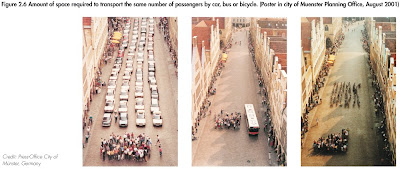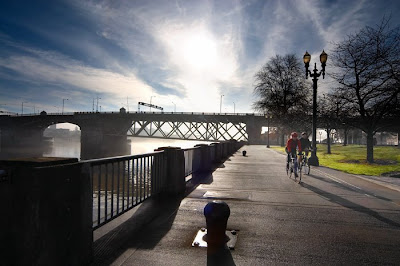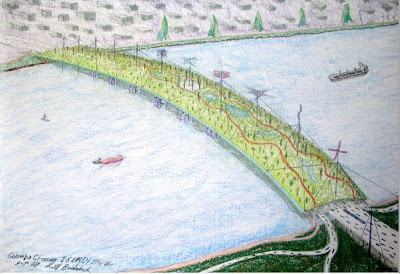It sounds obvious when you say it (and it has been said many times before) but it is always striking to see how influential modes of transportation are on the shaping of our cities. The magnitude and impacts are immense but also provide a range of new opportunities to explore. The typical figure ground study shows the differences and similarities of building and ‘open space’ – but misses the complexities of what these places are like experientially and ecologically. While some recent car-free cities have been proposed in other countries – is this a feasible option. It may be a fact of life that cars (in some way) will continue to have a sizable impact on planning for the foreseeable future.

:: image via Treehugger
To illustrate this point further, via Core77, a poster from the German city of Munster’s planning office, showing the relative space taken up to transport the same number of people by auto, bus, and bike. Looks like bus and bike win out there hands down, what a surprise. (click to enlarge for more detail)

:: image via Core77
To put this in some numerical terms (somewhat non-spatial) a few choice stats from Yes! Magazine to reinforce the point some more:
:: Number of jobs created by spending $1 billion on defense: 8,555
:: Number of jobs created by spending $1 billion on health care: 10,779
:: Number of jobs created by spending $1 billion on education: 17,687
:: Number of jobs created by spending $1 billion on mass transit: 19,795 [source]
Or to put it more succinctly, the : “…amount of money that a community gains for every mile biked instead of driven: 50 cents [source]” This is reinforced with a call for real cost impacts of roads, challenging some of our existing and dated aesthetic notions, as well as striving for more ‘Complete Streets’. This also involves re-envisioning the use of space in cities such as inventive new uses of alleys as well as perhaps redefining what it means to park downtown. Nonetheless, the web we weave is still there.

:: image via Treehugger
But we’re talking about space, so what does this mean in terms of design? A compelling guest post on Where by Ella Peinovich describes some of the experience with a Winy Mass studio class aimed at ‘Designing SkyCar City’ … which essentially had a simple aim: “…create a city built for the use of a skycar, a city with ‘streets’ at any level, or perhaps empty of streets as we know them…”

:: Futuristic Skycar – image via Skyaid
The essay mentions a companion book published of the solutions. One aspect that Ms. Peinovich addresses is the utopian tendency to want to make car-free cities – mostly as a cop-out to real problem solving of real problems. Here quote, again from Where: “…It is our responsibility as designers to address real issues rather than represent feel-good utopias. A city model that is designed in reaction to current outstanding issues of common society (e.g. waste disposal, greening, traffic relief etc…) will likely get a lot of attention and praise. On the contrary, our city model chose to explore and build up a topic which currently carries a negative stigma. We suggested that, as a society, we accept that every person wants the freedom of having their own car. We chose to assume this desire of every individual and suggest that public transportation has no future. We feel our model holds its clout because it is based on realistic projections of where society IS headed, rather than where it SHOULD be.”
Well the promise of Skycars has not panned out so far, so perhaps looking at some of the materials in which to make space for our cars (and bikes, and people). Much press has been devoted to a variety of permeable options, which have a range of pros and cons. How about some other options? Jetson Green mentioned a recent project with: “…a Dutch office building that is both heated and cooled using heat (or cold) from the asphalt of the road outside the building, as opposed to the more conventional use of solar thermal panels on the building’s roof.”

:: image via Jetson Green
While not a flawless solution, the multi-functional aspects of this paving are laudable. Removal and/or burial is a great option as well. The Big Dig is finally completed and Boston is realizing the potential of this new found ribbon of open space and building areas within the fabric of the city. Adaptive reuse at it’s finest. A profile in the NY Times showed some of this transformation.

:: images via NY Times
The benefits are huge, but burial is a problematic and expensive endeavor. Next option, get rid of the street. Portland (I brag) was on this trend previously, with the removal of Harbor Drive Highway that sliced through downtown alongside the riverfront, severing any connection to the river. In the earlier 1970s, the highway was removed and has become one of the most popular park spaces in the City.

:: Harbor Drive (1964) – image via Removing Freeways – Restoring Cities
What the drawings lack in refinement, they definitely make up for in vision. Definitely more poetic that the latest versions of the CRC, to say the least… or an opportunity to not just build a road, but build some community.



